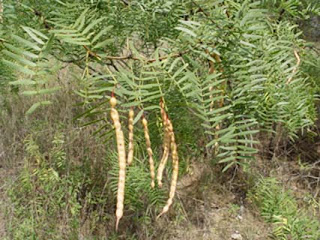The Medicinal Mesquite

Thought I'd share a amazing article I found online. I will write later about the mesquite bread and syrup we made today. Enjoy and Happy Friday.
Mesquite, The Rediscovered Food Phenomenon
Growing up in South Texas meant that chewing on mesquite pods was a part of childhood, like kids from Iowa sucked on honeysuckle. The sweet taste of the bright yellow beans was a favorite treat of the young cow pokes and Native Americans. Little did these children know that for 2,000 years mesquite was a source of nutrition for Native Americans and indigenous peoples in the arid regions of the Earth.
Ask most Americans about mesquite and they will know it as a source of flavoring on the grill. They talk of restaurants that promote their mesquite grilled meats. They report using this extraordinary hard wood to add a distinct smoky, sweetness to grilled foods. Some have used wood for fuel, furniture or flooring. Unfortunately, few have experienced the delectable flavor of the ground pods.
The mesquite tree grows in the desert regions throughout the world, areas not suitable for most agriculture. These trees can be found in the US from central Texas to southeastern California and up in the Utah. On 25% of the planet spices of mesquite, prosopis, can be found growing without any assistance from fertilizers, pesticides, irrigation or capitalization. These trees take little cultivation. The amount of nutrition supplied by mesquite trees is quite astounding. In the Southwest of the US the tree is considered a weed by many ranchers who attempt to eradicate it in order to grow grass. In other parts of the world the pods are still harvested and ground into meal or flour. This is sustainable agriculture at its most basic level, people supporting life naturally off the plants that grow around them.
For Native Americans in the Southwest and Mexico mesquite meal was an integral part of their daily diet. As these communities have moved away from the native desert foods and became more sedentary, obesity and diabetes has grown at an astounding rate. It is reported that 50% of the Pima and Tohono O’odham peoples have diabetes that is one in every two adults over 35 years of age suffer from diabetes. The removal of mesquite from their diets is believed to be one of the key reasons for these figures.
Diabetes is growing in the general US population too. Pediatricians are reporting it in children as young as 5 and researchers have seen a 70% increase in ages 18 – 22. Why are all these figures significant to an article about mesquite? Mesquite is a food that works to balance blood sugar. For 2,000 years the Native Americans in arid regions relied on mesquite as food staple. For 2,000 years a major part of their diets helped to regulate blood sugar. Diabetes did not exist in these communities when there diet consisted of native plants with mesquite being consumed in great quantities.
Researchers report that mesquite is highly effective in balancing blood sugar. The natural sweetness in the pods comes from fructose. Fructose does not require insulin to be metabolized making it safe for diabetics. The high rate of dietary fiber, pads are 25% fiber, causes the nutrients in mesquite to be absorbed slowly preventing the spikes and valleys in blood sugar. With a glycemic index of 25, mesquite requires a longer time to digest then many grains. The digestive time for mesquite is to 4 to 6 hours unlike wheat that digests in 1 to 2 hours. These factors result in a food that maintains a constant blood sugar for a sustained time and as a result prevents hunger. Here is a food that supports the diabetic’s diet and helps maintain a healthy insulin system in those not affected with blood sugar problem.
Mesquite flour not only stabilizes blood sugar but it tastes great with a sweet, slightly nutty with a hint of molasses flavor. Further this food delivers a big hit of nutritional value. It is high in dietary fiber and protein including lysine. The ground pods are between 11% and 17% protein. Mesquite is a good source of calcium, magnesium, potassium, iron, and zinc. Mesquite is low carbohydrate, low glycemic and low in fat.
This fragrant flour can be used in baking or as a seasoning on food and in drinks. In baking it the taste becomes quite strong if over 25% mesquite is used. It’s hard to beat the taste of pancakes, muffins, cakes, corn bread or cookies baked with the addition of mesquite. It can be sprinkled generously on food as a seasoning and used in breading for meat and fish. One mesquite specialist adds it to morning smoothies and finds he doesn’t get hungry mid morning. Mixes are now available that combine mesquite with other gluten free flours make experimenting with this amazing flour easy.
How can you lose trying a native food that:
* Has sustained desert dwellers for centuries
* Has a low glycemic index
* Is a source of calcium, magnesium, potassium, iron, and zinc
* Adds vegetable protein including lysine to the diet
* Supports sustainable agriculture world wide
* Can be used as a tasty condiment or in baking
Found At: http://www.foodreference.com/html/artmesquite.html
Until Next Time,
Tracy


Great info. Having kinfolk who are San Felipe Indians, plus learning from my friends in TX, I knew of medicinal uses of mesquite. Personally I have not had the experience of eating a pod right off the plant...now that you have spiked my interest, I am going to have to do something about it. Thanks for this interesting post.
ReplyDeleteBlessings
I've never heard of Mesquite before..thank you for the info!!
ReplyDelete